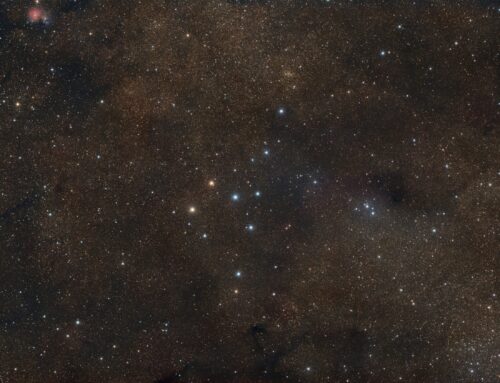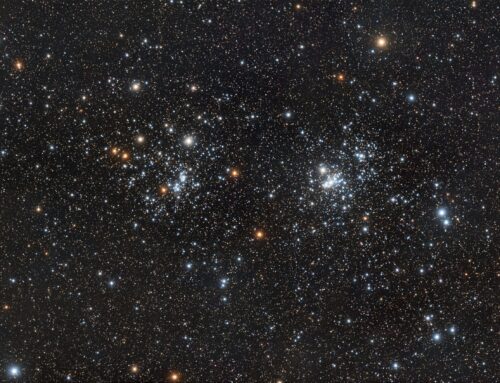NGC 6940
Click image for full size version
September 7, 2020
For this image, I decided to take my own advice from my Sky & Telescope article “Imaging in Bright Skies” (Nov. 2017). Open clusters rarely get imaged, with most imagers preferring objects that show more colour and detail. But open clusters are perfect targets for a bright, moonlit night. I imaged NGC 6940 on the night of the September 2020 full Moon. I also viewed it at low power through my homemade 10″ f/6 reflector, and with some 10×42 binoculars. It is gorgeous in a wide visual field, where the stellar concentration of the cluster is obvious and every star is like a pin prick. Photographs show more colourful stars, but don’t have the same impact for me as the eyepiece view.
NGC 6940 is located in Vulpecula, the Little Fox, in a very rich starry field near the border with Cygnus. It’s located about 2500 light years away, and covers an area of sky a little smaller than the Moon. NGC 6940 is particularly rich in red giant stars, and is thought to be around 1.1 billion years old. Most of the brighter bluish stars in this image are much younger, and not part of the cluster; they just grace the same field of view.
Tekkies:
Acquisition, focusing, and control of Paramount MX mount (unguided) with TheSkyX. Focus with Optec DirectSync motor and controller. Automation with CCDCommander. Equipment control with PrimaLuce Labs Eagle 3 Pro computer. All pre-processing and processing in PixInsight. Acquired from my SkyShed in Guelph. Average transparency and good seeing. Data acquired Sept 2-3, 2020 under a full Moon.
Luminance: Sky-Watcher Esprit 150 f/7 refractor and QHY 16200-A camera with Optolong UV/IR filter
Chrominance: Takahashi FSQ-106 ED IV @ f/3.6 and QHY367C one-shot colour camera with Optolong UV/IR filter
Chrominance: 12 x 3m = 0hr36m
Total: 1hr36m
Data Reduction and Initial Processing
Preprocessing: The WeightedBatchPreProcessing script was used to create a Luminance master frame (from the mono camera) and a RGB master frame (from the one-shot colour camera).
Gradient Removal: ABE was applied to L and RGB masters using Subtraction.
Colour
Colour Balancing: Colour was balanced with PhotometricColorCalibration.
Linear Noise Reduction: MultiscaleLinearTransform was used to reduce noise in the background areas, using an internal mask to protect bright structures. Layer settings for threshold and strength: Layer 1: 5.0 0.85, 2 iterations; Layer 2: 3.5, 0.75, 2 iterations.
Stretching: HistogramTransformation was applied to make a pleasing, bright image, with background set to an intensity of approximately 0.10.
Lightness
Linear Noise Reduction: MultiscaleLinearTransform was used to reduce noise in the background areas, using an internal mask to protect bright stars. Layer settings for threshold and strength: Layer 1: 3.0 0.85, 1 iterations; Layer 2: 2.0, 0.75, 2 iterations.
Stretching: HistogramTransformation was applied to make a pleasing, bright image, with background set to an intensity of approximately 0.10.
Combining Lightness and Colour Images
LRGB Combination: The lightness image was applied to the RGB image using LRGBCombination with default settings.
Additional Processing
Nonlinear Noise Reduction: TGVDenoise was used in L*a*b* mode to reduce noise with a mask used to target the background areas and protect the stars (max. 1,000 iterations and convergence selected for both lightness and chrominance).
Final Steps: Background and star brightness, contrast, and colour saturation were adjusted in several iterations using CurvesTransformation with masks as required. ICCProfileTransformation (sRGB IEC61966-2.1; Relative Colorimetric with black point compensation) was applied prior to saving in jpg format.







Beautiful image!!
Nice image! Incredible detail.